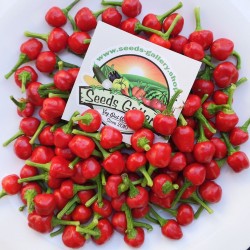Menu
-
MenuBack
- Home
-
Categories
-
-
Categories
-
Vegetable Seeds
-
Varieties by Country
- Varieties from Armenia
- Varieties from BiH
- Varieties from Croatia
- Varieties from France
- Varieties from Germany
- Varieties from Greece
- Varieties from Hungary
- Varieties from India
- Varieties from Italy
- Varieties from Japan
- Varieties from North Macedonia
- Varieties from Peru
- Varieties from Russia
- Varieties from Serbia
- Varieties from Slovenia
- Varieties from Spain
- Varieties from Thailand
- Varieties from Turkey
- Varieties from USA
- Tomato Seeds
- Corn Seeds
- Gourd family
- Bean family
- Cucumber Seeds
- Pepper Seeds
- Carrot family
- Onion family
- Lettuce Seeds
- Potato family
- Cabbage family
- Radish Seeds
- Beetroot family
- Watermelon Seeds
- Melon Seeds
- Cauliflower Seeds
- Sunflower family
-
Varieties by Country
- Fruit Seeds
- Chili - Habanero Seeds
- Medicinal Herb Seeds
- Climbing Plants Seeds
- Trees Bonsai Seeds
- Palm Seeds
- Ornamental Grasses Seeds
- Tobacco Seeds
-
Vegetable Seeds
-
-
-
-
- NEW PRODUCTS
- Create account
- Delivery - Payment
- FAQ
List of products by brand Seeds Gallery
Seeds produced by Seeds Gallery
Seeds produced by Seeds Gallery
There are 408 products.
Showing 385-396 of 408 item(s)
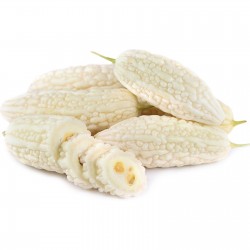
White Bitter Melon Seeds...
Price
€6.50
SKU: V 7 B
Seeds Gallery Com,
5/
5
<h2 class=""><strong>White Bitter Melon Seeds, Bitter Gourd, Balsam Pear (Momordica Charantia)</strong></h2>
<h2><span style="color: #ff0000;"><strong>Price per pack of 5, 10, 50, 100 seeds.</strong></span></h2>
<p>If the Balsam Pear did not exist a pharmaceutical company would invent it. In fact, there have been some ten studies published this past year about it, the latest as of this writing in February 2008 in the Journal of Food Biochemistry about its potential in diabetes treatment.</p>
<p>A very common, bitter vegetable in Asian cuisine, the Balsam Pear, Momordica charantia, is a natural drug store for diabetics and others. It’s not a pear at all but a fruiting gourd and vine that smells like an old, well-used gym shoe. Don’t say you weren’t warned.</p>
<p>The warty gourd is edible when green (and cooked) but turns toxic when orange ripe. It then splits characteristically into three parts, revealing red arils (fleshy seed covers). The ripe seeds inside the arils and orange flesh of the gourd are toxic and can make one violently lose fluids from both ends, and induce abortions. The red arils around the seeds, however, are edible. And notice this: The arils are 96% lycopene, which gives them their color. Just remember to spit out the seed from each aril.</p>
<p>M. charantia is found Connecticut south to Florida, west to Texas, also Puerto Rico and the Hawaiian Islands. Incidentally, the bitter melon has twice the potassium of bananas and is also rich in vitamins A and C.</p>
<p>The Latin genus name, Momordica, (mo-MOR-dee-ka) means “to bite,” and refers to the jagged edges of the leaves, which appear as if they have been bitten. Charantia (char-AN-tee-ah) the species’ name, comes from Greek meaning beautiful flower. It’s native to tropical regions of the world though no one knows where it came from originally. Gray’s four-inch-thick Manual of Botany, started in 1850 and revised in 1950, makes no mention of M. charantia in the United States but it is currently a serious crop weed in Florida and to 21 other crops around the world, bananas to soybeans. It’s a latecomer to Florida or Gray was in the dark about it. In the Amazon, and as far away as India, it is used very much by local populations for food and medicine. Apparently a dynamic chemical factory, the M. charantia is being tested for treatment against cancer — leukemia in particular — AIDS, as an analgesic, and to moderate insulin resistance. It is often called vegetable insulin. It does not increase insulin secretion but “speeds up carbohydrate use of the cells by affecting membrane lipids.” Seems like the smelly gym shoe hanging on the fence has a great future. But, it is not for everyone: Don’t eat the vegetable if you’re hypoglycemic or pregnant. In diabetics, it can lower blood sugar too effectively. It also reduces fertility in men and women. And, it contains vicine. That can cause favism in people who have a variant glucose-6-phosphate dehydrogenase. (I presume if you don’t know what that is you don’t have it. Favism is a severe reaction to fava beans and or their pollen. Occurs most often in Mediterranean men.)</p>
<p>Cultivated versions of the M. charantia, also called Bitter Gourd or Wild Balsam Apple, are found in most Asian markets, and they, too, smell like an old gym shoe. The odor, thankfully, almost all goes away when cooked, and the bitterness moderates, but does not go away. If you are not yet brave enough to pick your own, you can buy some or grow it yourself. There are many varieties and numerous recipes are on the Internet. The M. charantia is indeed bitter. Some cut up the vegetable and soak it in water, or salted water and or blanch it to reduce the bitterness.</p>
<p>While I have never seen an Oriental family picking M. charantia off local fences here in Florida, I have seen many Hispanic families doing so. Dr. Julia Morton, a plant professor in south Florida, says besides the green fruit, the young leaves when cooked and drained are also edible and nutritious, with iron, phosphorous, calcium, and vitamin C. I have never managed to get past the locker room bouquet to toss ‘em in a pot, and the fruit is just too bitter for me to enjoy. The ripe fruit pulp has been used as a soap substitute, which should give you some idea of the flavor. In India and Africa, the cooked leaves are canned like spinach. The fragrant flowers can be used as a seasoning when cooking.</p>
<p>Incidentally, if you have a glut of green Bitter Gourds, you can slice them, partially boil them with salted water, then dry them, sun, or otherwise. They will last for several months. You can then fry them and use as you like. Also, drinking the fresh bitter juice is recommended by some naturopaths. That ain’t going to be easy, it’s really bitter…. much easier to tell someone to do it than do it yourself.</p>
<p>REMEMBER: No part of the Momordica charantia is ever to be eaten raw, except for the red arils (and remember to spit the seeds out.) No part, other than the arils, is ever to be eaten when ripe, which is when it is turning from green to yellow to orange. Do not eat the yellow or orange fruit raw or cooked. It is toxic. Also, the green fruit is suspected in the poisoning of dogs and pigs.</p>
<p>Relatives: Momordica balsamina, which has longer spines on the fruit and can ripen to red, grows only in St. Lucie County in Florida and only a smattering of places in the southern U.S. M. balsamina fruit can be pickled or after soaking used as a cooked vegetable. Young shoots and tendrils are boiled as a green. The seeds are eaten. Momordica cochinchinensis produces a huge round fruit that is red when ripe. Young fruit boiled, not as bitter as M. charantia. Momordica dioica, small and roundish, is more esteemed than the rest. It is not bitter but sweet. Fruits, shoots, leaves, and roots are boiled for food. There are also at least seven commercial cultivars of the Momordica gourds</p>
<p>IDENTIFICATION: Momordica charantia: A slender, climbing annual vine to 18 feet with long-stalked leaves and yellow flowers where the leaf meets the stem. Young fruit emerald green turning to orange when ripe. At maturity, the fruit splits into three irregular parts that curl backward showing many reddish-brown or white seeds encased in scarlet arils.</p>
<p>TIME OF YEAR: Fruit, summer, and fall in warm climates, fall in northern climes.</p>
<p>ENVIRONMENT: Love to climb, found in hammocks, disturbed sites, turf, and ornamental landscapes, and citrus groves. It seems to be the most common vine on chain link fences in Florida.</p>
<p>METHOD OF PREPARATION: None of it ripe except the arils. Boiled green fruit (including seeds) leaves and shoots, boiled twice. Or, cut open and remove seeds and fiber and parboil. Ripe parts toxic are too bitter to eat. (An adult can swallow hole two ripe seed and not have much distress.) Young leaves and shoots are boiled and eaten as a potherb. Flowers used as a seasoning.</p>
<p>HERB BLURB</p>
<p>Herbalists say the charantia has long been used to treat diabetes and a host of other ailments from arthritis to jaundice.</p>
<script src="//cdn.public.n1ed.com/G3OMDFLT/widgets.js"></script>
V 7 B

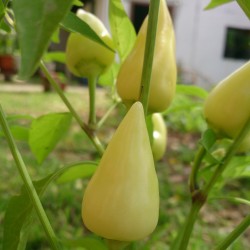
White Chili Seeds SPEAR
Price
€1.75
SKU: C 80
Seeds Gallery Com,
5/
5
<h2><strong>White Chili Seeds SPEAR</strong></h2>
<h2><span style="color:#ff0000;"><strong>Price for Package of 10 seeds.</strong></span></h2>
<p>Very hot Chili pepper, which also looks really good... The fruits are conical in shape and remain white for a long time and then ripen for a very short time and turn red. The fruits weigh on average up to 10 grams.</p>
<p>Because the plant does not grow tall (up to 40 centimeters), it is ideal for smaller pots to hold in an apartment, balcony. Of course, if you take it to a flat or basement in winter where the temperature does not drop below 0 the plant is perennial.</p>
C 80


Variety from America

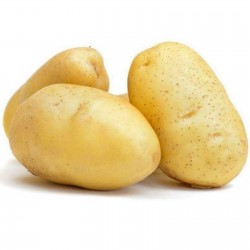
White Skin - White Flesh...
Price
€1.95
SKU: P 247 WK
Seeds Gallery Com,
5/
5
<h2><strong>White Skin - White Flesh KENNEBEC Potato Seeds</strong></h2>
<h2><span style="color:#ff0000;"><strong>Price for Package of 10 seeds.</strong></span></h2>
<p>These white-skinned and white flesh tubers make excellent table potatoes. The fairly firm texture when boiled. They are highly recommended for fries and chips. Plants are compact and erect with pointed smooth leaves and; numerous big white flowers with slight reddish-purple tinge on backs.</p>
<p>Potatoes can be grown from true seeds just as easily and reliably as tomatoes, peppers or eggplants. True potato seed is a new development offering the advantages of, lower cost than mini-tubers, completely disease-free, and always available at the right planting time for gardeners in any region. This is the new wave in potato culture.</p>
<p>Start indoors in seedling trays. Fill each cell to 1cm (1/2") from the top with sterilized seed starting mix. Moisten with water and place one seed on the top of the soil per cell. Cover with vermiculite and water in. Note: Potato seeds require light to germinate, so do not bury. Optimal soil temperature for germination: 15-27°C (65-80°F). Seeds should germinate in 6-10 days.</p>
<p><strong>Starting</strong><br />Keep the soil evenly moist during germination, but allow free drainage so that excess water does not collect. Water before mid-day to allow foliage to dry completely by nightfall. Potato seedlings <span>tend to stay prostrate immediately after emergence if they have 13 or more hours of daylight. As a somewhat longer stem is desired to ease transplanting, keep seedlings in about 12-hour light per day. During the last week expose seedlings to full sunlight to strengthen the stem. At optimal temperature, transplants will be ready 4 to 6 weeks after seeding.</span></p>
<p><span>If field conditions are very different from indoor conditions, allow one week of hardening off. Water the plugs heavily the day before and day of the transplant, and transplant into moist soil.</span></p>
<p><strong>Growing</strong><br />Ideal pH: 5.0-6.0. Plant seedlings so that only the crown of its top, 2-5cm (1-2“) is above soil level, burying the whole plug and a good part of the stem of the seedling. Seedlings cannot be completely buried, the growing point needs to stay above ground. Space seedlings 10-25cm (4-10") apart in rows 75cm (30") apart. Wider spacing produces fewer, but larger tubers. Keep the area well-watered for several weeks after transplant.</p>
<p><strong>Hilling<br /></strong><span>When seedlings reach 10-15cm (4-6") in height, they should be hilled, probably three weeks after transplanting. This operation takes soil from the centre of the row, and covers the seedlings up to half of their height, creating a small hill. It is best to work from the centre of the furrow towards the plants. Do not cut too deep into the soil near the plant to avoid root damage. Just before hilling, fertilizer can be applied near the base of the seedlings, and this will be covered when hilling.</span></p>
<p>A second hilling and side dressing of balanced organic fertilizer should follow 3-4 weeks after the first, again depositing soil up to half the height of the plants. Again, increase the depth of the furrow in its centre and bring this soil on top of the small hill created in the first hilling operation.</p>
<p><strong>Harvest</strong></p>
<p><span>In the garden, potatoes can be harvested without destroying the plant if only a few potatoes are needed. Carefully scrape soil near the base of the stem until the skin of a potato is found, and pull it from the stolon. Consume it that day for a tasty and nutritious meal. </span>If potatoes need to be stored for some time, remove the foliage 3 weeks before harvest. This "sets" (hardens) the skin, and it will store better as the thicker skin will reduce water loss from the tubers. Keep them dark up to 2 to 3 months at high humidity before eating.</p>
<p><strong>Seed Info</strong><br />In optimal conditions, at least 75% of the seeds will germinate. Usual seed life: 3 years. Per 100′ row: 200 seeds, per acre: 8.8M seeds.</p>
<p><strong>Diseases & Pests</strong><br />Protect from cabbage moths and other insect pests with floating row cover. Prevent disease with a strict 4-year crop rotation, avoiding planting Brassicas in the same spot more than once every four years.</p>
<p><strong>Companion Planting</strong><br />A worthy companion for beets, Brassicas, cucumbers, and onions. Avoid planting near peppers, pole beans, strawberries, and tomatoes.</p>
P 247 WK

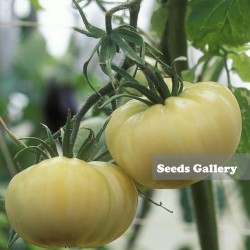
White Wonder Tomato Seeds
Price
€2.30
SKU: VT 29
Seeds Gallery Com,
5/
5
<h2><strong>White Wonder Tomato Seeds Great Taste Heirloom</strong></h2>
<h2><span style="color:#ff0000;"><strong> Price for Package of 5 or 10 seeds.</strong></span></h2>
<p>White Wonder tomatoes are creamy-white oblate shaped beefsteak tomatoes that weigh about 1 kg (2 pounds). The meaty flesh has few seeds and is also yellowish-white in color with high sugar content and low acidity, creating an exceptionally sweet melon-like flavor. The bushy indeterminate plants grow to an average of 1,5 meters (5 feet) tall, and they have good foliage cover to protect the fruit. As an indeterminate variety, the White Wonder tomato plant will continue to grow and produce good yields of the large tomatoes throughout the season right up until frost.</p>
<p>White Wonder is a beefsteak-type tomato, characterized by large, heavy fruit and thick, meaty texture. Tomatoes are members of the Solanaceae or nightshade family and they are botanically known as either Lycopersicon esculentum or Solanum Lycopersicum, as new DNA evidence has led some horticulturists to re-adopt the original classification. Like all heirlooms, White Wonder is an open-pollinated cultivar, meaning that saved seed being passed down through family generations grows true to the original parent type.</p>
<p>White Wonder tomatoes have a high sugar level and are deliciously sweet, making them great for fresh eating. They add a beautiful contrast to veggie trays alongside other colored tomato varieties. As a beefsteak-type tomato, they are great for slicing onto sandwiches, burgers, and salads, and they are also a good variety for canning. Try using them to make white tomato soup or white tomato sauce. Tomatoes pair well with savory herbs and soft cheeses, and they can also be combined with sweet herbs, like mint. Store White Wonder tomatoes at room temperature until fully ripe, after which refrigeration can slow the process of decay.</p>
<p>White Wonder tomatoes were brought into the spotlight when they became one of the varieties chosen for Alice Waters’ famous Chez Panisse restaurant in Berkeley, California. Chez Panisse opened its doors in 1971 and is known for sourcing ingredients that are organically and locally grown and ecologically harvested to protect the land for future generations.</p>
<p>Geography/History<br />The White Wonder tomato is an old American heirloom believed to date back as far as pre-1860. Some even suspect that Thomas Jefferson planted this variety at his home in Monticello. Like all tomatoes, White Wonder tomatoes cannot stand any frost, and they are sensitive to low night temperatures. They are said to do best in USDA hardiness zones 3-9.</p>
<p>HEIRLOOM TOMATO: Heirloom Tomatoes are just what their name implies. They have been handed down, through generations of farmers and gardeners, from family member to family member. Many of these tomato varieties are known to have thrived since the 1800’s.</p>
<p>Unlike hybrids, they are not selectively bred for taste or appearance. They are open-pollinated, growing ‘true to type’ plants, like their predecessors, from seed. Heirloom Tomato Plants will add untraditional color and pleasing variety to your garden harvest.</p>
VT 29 (10 S)


Bosnia and Herzegovina variety
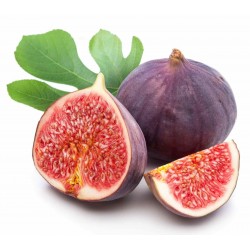
Wild Fig Seeds (from...
Price
€1.85
SKU: V 19 WF
Seeds Gallery Com,
5/
5
<!DOCTYPE html>
<html>
<head>
<meta http-equiv="Content-Type" content="text/html; charset=UTF-8" />
</head>
<body>
<h2><strong>Wild Fig Seeds (from Herzegovina)</strong></h2>
<h2><span style="color: #ff0000;"><strong>Price for Package of 20 seeds.</strong></span></h2>
<p>We brought this fig from Herzegovina and we found it in the mountains in complete wilderness. Its habitat was rocky and dry, which means that it is resistant to poor soil conditions. There are also constant droughts in that part and despite the fact that the plant did not get much water, it did not bother it to grow at all. The fruits are smaller than other varieties of figs and dark purple when ripe. Although the fruits are small they are very tasty and sweet. From reliable sources, we learned that where we took it, the temperature dropped to -15C in winter.</p>
<p>Fig flowers are difficult to spot because they grow inside figs and such flowers are pollinated by the so-called. fig wasps, which develop in the fruits of the wild fig. The difference between a tame and a wild fig is that the tame fig blooms only with female flowers while the wild fig has female and male flowers.</p>
<p>Wild figs grow at an abnormal rate compared to tame ones.</p>
</body>
</html>
V 19 WF (20 S)

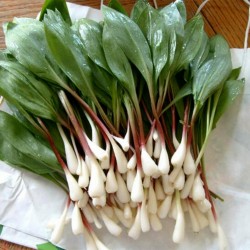
Wild Garlic, Bear's Garlic...
Price
€2.35
SKU: MHS 15
Seeds Gallery Com,
5/
5
<h2 class=""><strong>Wild Garlic, Bear's Garlic Seeds (Allium ursinum)</strong></h2>
<h2><span style="color: #ff0000;"><strong>Price for Package of 10 or 50 (0.288g) seeds.</strong></span></h2>
<p>Allium ursinum – known as ramsons, buckrams, wild garlic, broad-leaved garlic, wood garlic, bear leek, or bear's garlic – is a wild relative of chives native to Europe and Asia. The Latin name is due to the brown bear's taste for the bulbs and its habit of digging up the ground to get at them, they are also a favourite of wild boar. In Europe, where ramsons are popularly harvested from the wild, similarity to poisonous plants such as lily of the valley or Colchicum autumnale regularly leads to cases of poisoning.</p>
<p>Allium ursinum is a bulbous, perennial herbaceous monocot, that reproduces primarily by seed. The narrow bulbs are formed from a single leaf base and produce bright green entire, elliptical leaves up to 25 cm long x 7 cm wide with a petiole up to 20 cm long. The inflorescence is an umbel of six to 20 white flowers only, lacking the bulbils produced by some other Allium species such as Allium vineale (crow garlic) and Allium oleraceum (field garlic). :394 :902 The flowers are star-like with six white tepals, about 16–20 mm in diameter, with stamens shorter than the perianth.</p>
<p>It flowers in the British Isles from April to June, :394 starting before deciduous trees leaf in the spring. The flower stem is triangular in cross-section and the leaves are broadly lanceolate similar to those of the lily of the valley (Convallaria majalis).</p>
<p><strong>Distribution</strong></p>
<p>It is native to temperate regions of Europe, from Britain east to the Caucasus. It is common in much of the lowland British Isles with the exception of the far north of Scotland, Orkney, Shetland, and the Channel Islands.</p>
<p><strong>Habitat</strong></p>
<p>A. ursinum is widespread across most of Europe. It grows in deciduous woodlands with moist soils, preferring slightly acidic conditions. In the British Isles, colonies are frequently associated with bluebells (Hyacinthoides non-scripta), especially in ancient woodland. It is considered to be an ancient woodland indicator species</p>
<p><strong>Edibility</strong></p>
<p>The leaves of A. ursinum are edible; they can be used as salad, herb, boiled as a vegetable, in soup, or as an ingredient for a sauce that may be a substitute for pesto in lieu of basil. The stems are preserved by salting and eaten as a salad in Russia. A variety of Cornish Yarg cheese has a rind coated in wild garlic leaves. The bulbs and flowers are also edible. It is used for preparing herbed cheese, a Van speciality in Turkey.</p>
<p>The leaves are also used as fodder. Cows that have fed on ramsons give milk that tastes slightly of garlic, and butter made from this milk used to be very popular in 19th-century Switzerland.</p>
<p>The first evidence of the human use of A. ursinum comes from the Mesolithic settlement of Barkær (Denmark), where an impression of a leaf has been found. In the Swiss Neolithic settlement of Thayngen-Weier (Cortaillod culture), a high concentration of pollen from A. ursinum was found in the settlement layer, interpreted by some as evidence for the use of A. ursinum as fodder.</p>
<p><strong>Similarity to poisonous plants</strong></p>
<p>The leaves of A. ursinum are easily mistaken for lily of the valley, sometimes also those of Colchicum autumnale and Arum maculatum. All three are poisonous. Grinding the leaves between the fingers and checking for a garlic-like smell can be helpful, but if the smell remains on the hands, one can easily mistake a subsequent poisonous plant for bear garlic. When the leaves of A. ursinum and Arum maculatum first sprout, they look similar but unfolded Arum maculatum leaves have irregular edges and many deep veins, while ramsons leaves are convex with a single main vein. The leaves of lily of the valley are paired, dull green and come from a single reddish-purple stem, while the leaves of A. ursinum emerge individually and are bright green.</p>
<h3><strong>Sowing:</strong></h3>
<p>Sow in late winter/late spring and late summer/autumn. The seeds need moist loamy soil with a damp shady environment. Sow either in situ or in a cold frame. It takes 200 seeds per square meter.</p>
<h3><strong>Sowing Indoors:</strong></h3>
<p>Wild Garlic sets seed profusely and germinates well. Plants should be large enough for planting out by the third year.</p>
<h3><strong>Sowing Direct:</strong></h3>
<p>Scatter the seed on bare soil under trees. Lightly roll the soil but do not rake over. Seeds can be sown at a rate of up to 200 seeds per square meter.</p><script src="//cdn.public.n1ed.com/G3OMDFLT/widgets.js"></script>
MHS 15 (10 S)

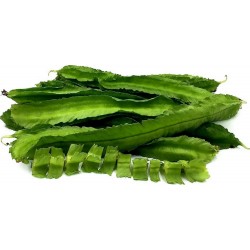
Winged Bean Seeds...
Price
€2.20
SKU: VE 186
Seeds Gallery Com,
5/
5
<meta http-equiv="Content-Type" content="text/html; charset=UTF-8" />
<div id="idTab1" class="rte">
<h2 id="short_description_content"><strong>WINGED BEAN Seeds (Psophocarpus tetragonolobus)</strong></h2>
<h2><span style="color: #f50303;"><strong>Price for Package of 5 seeds.</strong></span></h2>
<p>The winged bean (Psophocarpus tetragonolobus), also known as the Goa bean, asparagus pea, four-angled bean, four-cornered bean, Manila bean, Mauritius bean, and winged pea, is a tropical legume plant native to New Guinea. It grows abundantly in hot, humid equatorial countries, from the Philippines and Indonesia to India, Burma, Thailand and Sri Lanka. It is widely known, yet grown on a small scale in Southeast Asia and Papua New Guinea. Winged bean is well-recognized by farmers and consumers in the Asian region for its variety of uses and disease tolerance. Winged bean is nutrient-rich, and all parts of the plant are edible. Leaves can be eaten like spinach, flowers can be used in salads, tubers can be eaten raw or cooked, seeds can be used in similar ways as the soybean. The winged bean is an underutilized species but has the potential to become a major multi-use food crop in the tropics of Asia, Africa and Latin America.</p>
<p> </p>
<p>The winged bean is a species that belongs to the genus Psophocarpus, a genus of 6-9 varying species. Species in the Psophocarpus genus are perennial herbs grown as annuals. They are generally considered to be from Africa. Species in the Psophocarpus species are capable of climbing by twining their stems around a support. Species in the Psophocarpus genus have tuberous roots and pods with wings.</p>
<p> </p>
<p><strong>Appearance</strong></p>
<p>The winged bean plant grows as a vine with climbing stems and leaves, 3–4 m in height. It is an herbaceous perennial, but can be grown as an annual. It is generally taller and notably larger than the Common bean. The bean pod is typically 15–22 cm (6–9 in) long and has four wings with frilly edges running lengthwise. The skin is waxy and the flesh partially translucent in the young pods. When the pod is fully ripe, it turns an ash-brown color and splits open to release the seeds. The large flower is a pale blue. The beans themselves are similar to soybeans in both use and nutritional content (being 29.8% to 39% protein).</p>
<p> </p>
<p>There is abundant variation in the appearance of winged bean. The shape of its leaves ranges from ovate, deltoid, ovate-lanceolate, lanceolate and long lanceolate. The leaves of winged bean also vary in colour appearing as different shades of green.</p>
<p> </p>
<p>Stem colour is commonly green, but can vary from shades of green to shades of purple.</p>
<p> </p>
<p>Pod shape is most commonly rectangular, but can also appear flat. Pod colour may also vary from shades of cream, green, pink or purple. The exterior surface of the pod also varies in texture. Pods can appear smooth or rough depending on genotype. Seed shape is often round, but oval and rectangular seeds are also found. Seed colour changes based on environmental factors and storage conditions. Seeds may appear white, cream, brown or dark tan in appearance. The shape of winged bean tuberous roots also show variation.</p>
<p> </p>
<p><strong>Human consumption and nutrition</strong></p>
<p>One of the advantages of the winged bean is its ability to produce food from many different parts of the plant.</p>
<p> </p>
<p>Pods- Can be eaten unripe as a crunchy vegetable, cooked or raw</p>
<p> </p>
<p>Seeds- Require cooking for 2–3 hours to destroy trypsin inhibitors and hemagglutinins that inhibit digestion.[4] Seeds can be roasted like peanuts and have nutrient value comparative to soy beans. Average about 35% protein and 17% oil.</p>
<p> </p>
<p>Roots-Can be eaten raw or cooked. Tubers are high in protein and nutrient rich. Tuberous roots have 20% protein, which is much higher than other edible roots.</p>
<p> </p>
<p>Leaves and Flowers- Can be eaten raw or cooked. Flowers and leaves also have a high protein content at 10-15%.</p>
<p> </p>
<p><strong>Germination</strong></p>
<p>Winged bean is a self-pollinating plant but mutations and occasional outcrossing, may produce variations in the species. The pretreatment of winged bean seeds is not required in tropical climate, but scarification of seeds has shown to enhance the germination rate of seedlings. Seed soaking may also increase speed to germination, as is typical, and may be used in conjunction with scarification. Seedlings under natural field conditions have been reported to emerge between 5–7 days.</p>
<p> </p>
<p>It is recorded that winged bean can grow as fast or faster than comparative legume plants including soybeans. There is a 40-140 day period of germination from sowing to flowering of the winged bean plant. The pod reaches its full length and can be gathered to use as a vegetable 2 weeks after pollination. Three weeks after pollination, the pod becomes fibrous and after six weeks mature seeds can be harvested. Tuber development and flower production are dependent upon genotype and environmental factors. Some varieties of winged bean do not produce tuberous roots. The winged bean is a tropical plant, and will only flower when the day length is shorter than 12 hours, though some varieties have been reported as day-length neutral. All varieties of winged bean grow on a vine and must grow over a support. Some examples of support systems include: growing against exterior walls of houses, huts, buildings; supporting against larger perennial trees; stakes placed in the ground vertically; and structures made from posts and wires.</p>
<p> </p>
<p>Because the early growth of winged bean is slow, it is important to maintain weeds. Slow early growth makes winged bean susceptible to weed competition in the first 4–6 weeks of development. Khan (1982) recommends weeding by hand or animal drawn tractor two times before the support system of the winged bean is established.</p>
<p> </p>
<p>Winged bean can be grown without added fertilizer as the plant has a bacterium on the nodules of the roots that fixes nitrogen and allows the plant to absorb nitrogen. Factors that influence nitrogen fixation include, Rhizobium strain, interactions between strain and host genotype, available nutrients and soil pH.</p>
<p> </p>
<p><strong>Climate</strong></p>
<p>Winged bean thrives in hot weather and favours humidity, but it is an adaptable plant. It is reported that the winged bean can adjust to the climate of the equatorial tropics. Winged bean production is optimal in humidity, but the species is susceptible to moisture stress and waterlogging. Ideal growing temperature is reported to be 25 degrees Celsius. Lower temperature is reported to suppress germination, and extremely high temperatures are detrimental to the yield of the plant.</p>
<p> </p>
<p>Moderate variations in the growing climate of winged bean can result in variations in yield. It is reported than growing winged bean in lower than favourable temperatures can increase tuber production. It is also reported that leaf expansion rate is higher in a warmer climate. In addition to adequate temperature, winged bean requires sufficient soil moisture at all stages of growth to produce high yields. Although the winged bean plant is indigenous to the humid tropics, it is possible for the plant to succeed in drier climate with plenty of irrigation. Success has been noted when the maturity of the plant and the drier part of the growing season correspond.</p>
<p> </p>
<p>The hot, humid, and relatively wet summers of the Mid-Atlantic/Northeast are sufficient to raise the plant to crop, though the shorter growing season and day-length flowering issues will restrict the timing and amounts of yields.</p>
<p> </p>
<p><strong>Uses</strong></p>
<p>This bean has been called the "one species supermarket" because practically all of the plant is edible. The beans are used as a vegetable, but the other parts (leaves, flowers, and tuberous roots) are also edible. The tender pods, which are the most widely eaten part of the plant (and best eaten when under 1" in length), can be harvested within two to three months of planting. The flowers are often used to color rice and pastries. The flavor of the beans has a similarity to asparagus. The young leaves can be picked and prepared as a leaf vegetable, similar to spinach. The roots can be used as a root vegetable, similar to the potato, and have a nutty flavor; they are also much richer in protein than potatoes. The dried seeds can be useful as a flour and also to make a coffee-like drink. Each of these parts of the winged bean provide a source of vitamin A, vitamin C, calcium, iron, and other vitamins. The seeds contain 35% protein and 18% oil.</p>
<p> </p>
<p><strong>Potential</strong></p>
<p>The winged bean is rich in protein and tocopherol, an antioxidant that increases vitamin A use in the body (National Research Council (U.S), 1975). Its ability to grow in heavy rainfall makes the species a good candidate to adequately nourish the people of tropical equatorial countries in Africa. The wing bean can also be used to produce winged bean milk made from water, winged beans, and emulsifier. Winged bean milk has similar characteristics as soymilk without the same bean-rich flavour. Winged bean has also been reported as an effective remedy for smallpox and as a cure for vertigo in Malaya.</p>
<p> </p>
<p>The winged bean also provides many opportunities for economic benefit. Many parts of the winged bean can be sold. Mature seeds can bring in a high price . There is evidence of smoked pods, uncooked tubers, cooked tubers, dry seeds, and leaves being sold in domestic markets in South East and South Asia. Winged bean also has the potential to be used as animal feed for livestock and poultry. The winged bean also has the potential to be used as a replacement for fish meal used to raise African catfish (Clarias gariepinus), a highly valued food fish in Africa. Feeding fish represents a large portion of operating cost for fish farmers and fishmeal is scarce and high-priced. Winged bean can be used as the primary protein source for fish feed to reduce farmer dependence on fish meal availability.</p>
<p> </p>
<p>Winged bean also shows potential as a cover crop and a restorative crop. Planting winged bean uniform with the ground can reduce weeds and function well as a cover crop. The winged bean can also function effectively as a restorative crop that can improve nutrient poor soil with nitrogen when it is turned over into the soil.</p>
</div>
VE 186 (5 S)

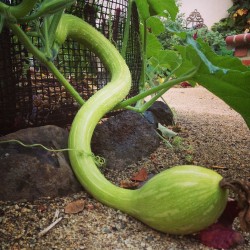
Winter squash Seeds...
Price
€2.35
SKU: VG 10
Seeds Gallery Com,
5/
5
<!DOCTYPE html>
<html>
<head>
<meta http-equiv="Content-Type" content="text/html; charset=UTF-8" />
</head>
<body>
<h2><strong>Winter squash Seeds TROMBETTA DI ALBENGA</strong></h2>
<h2><span style="color: #ff0000;"><strong>Price for Package of 3 seeds.</strong></span></h2>
<p>Trombetta di Albenga is an Italian heirloom climbing winter squash. It’s a highly valuable variety, with a delicate flavor.</p>
<p>The plant is a strong climber, with broad leaves, its fruits are thin, slightly crooked, trumpet-shaped, the skin is pale green when unripe and yellow when ripe.</p>
<p>Fruits can grow up to 1 m long, weighing as much as 5kg, but they are usually harvested when 20-30 cm long and used as courgettes. If harvested when 10-15 cm long they are very tender and can be eaten raw. The flesh of the ripe fruits is cooked to prepare puree, soups, ravioli stuffing or cakes. Seeds can be eaten lightly toasted and salted.</p>
<p>Produces long, slender, white to pale yellow, 15-inch fruit with a bulb at the bottom. Picked while young and tender, they are delicious and sweet as summer squash. If allowed to mature, this is also great as winter squash. As winter squash, it is used for stuffing in gnocchi and ravioli, & for baking and pies!</p>
<p>The mature fruit grows very long. Because of their unique shape and delicious flavor, they are in very high demand at specialty markets but can be a pain to store, for the same reason.</p>
<p>Trombetta di Albenga grows as an Annual and is a Vegetable. Being an Annual, it tends to grow best over the course of a single year. Trombetta di Albenga is known for its Vine habit and growing to a height of approximately 2.00 meters (6.50 feet). Expect to bloom to occur in early summer.</p>
<p>Italy is believed to be where Trombetta di Albenga originates from.</p>
<p>This plant tends to need a moderate amount of maintenance, so ensuring that you are aware of the soil, sun, ph and water requirements for Trombetta di Albenga Winter squash is quite important to ensure you have a happy and healthy plant.</p>
</body>
</html>
VG 10 (3 S)


Best seller product

This plant is resistant to winter and frost.
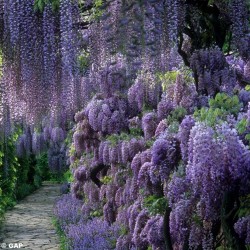
Wisteria Seeds (Wisteria...
Price
€3.00
SKU: T 46
Seeds Gallery Com,
5/
5
<meta http-equiv="Content-Type" content="text/html; charset=UTF-8" />
<h2><strong>Wisteria Seeds (Wisteria sinensis)</strong></h2>
<h2><span style="color: #ff0000;"><strong>Price for Package of 5 or 10 seeds.</strong></span></h2>
<p>Wisteria (also spelled Wistaria or Wysteria) is a genus of flowering plants in the pea family, Fabaceae, that includes ten species of woody climbing vines native to the Eastern United States and to China, Korea, and Japan. Some species are popular ornamental plants, especially in China and Japan. An aquatic flowering plant with the common name wisteria or 'water wisteria' is in fact Hygrophila difformis, in the family Acanthaceae.</p>
<p><span style="font-size: 12pt;"><strong>Description</strong></span></p>
<p>Wisteria vines climb by twining their stems either clockwise or counterclockwise round any available support. They can climb as high as 20 m above the ground and spread out 10 m laterally. The world's largest known Wisteria vine is in Sierra Madre, California, measuring more than 1 acre (0.40 ha) in size and weighing 250 tons. Planted in 1894, it is of the Chinese lavender variety.</p>
<p>The leaves are alternate, 15 to 35 cm long, pinnate, with 9 to 19 leaflets. The flowers are produced in pendulous racemes 10 to 80 cm long, similar to those of the genus Laburnum, but are purple, violet, pink or white. There is no yellow on the leaves. Flowering is in the spring (just before or as the leaves open) in some Asian species, and in mid to late summer in the American species and W. japonica. The flowers of some species are fragrant, most notably Chinese Wisteria. The seeds are produced in pods similar to those of Laburnum, and, like the seeds of that genus, are poisonous.</p>
<p>Wisteria is an extremely hardy plant that is considered an invasive species in many parts of the U.S., especially the Southeast, due to its ability to overtake and choke out other native plant species.</p>
<p>Wisteria species are used as food plants by the larvae of some Lepidoptera species including brown-tail.</p>
<p><strong>Cultivation</strong></p>
<p>Wisteria, especially Wisteria sinensis, is very hardy and fast-growing. It can grow in fairly poor-quality soils, but prefers fertile, moist, well-drained soil. They thrive in full sun. Wisteria can be propagated via hardwood cutting, softwood cuttings, or seed. However, specimens grown from seed can take decades to bloom; for this reason, gardeners usually grow plants that have been started from rooted cuttings or grafted cultivars known to flower well.[citation needed] Another reason for failure to bloom can be excessive fertilizer (particularly nitrogen). Wisteria has nitrogen fixing capability (provided by Rhizobia bacteria in root nodules), and thus mature plants may benefit from added potassium and phosphate, but not nitrogen. Finally, wisteria can be reluctant to bloom because it has not reached maturity. Maturation may require only a few years, as in Kentucky Wisteria, or nearly twenty, as in Chinese Wisteria. Maturation can be forced by physically abusing the main trunk, root pruning, or drought stress.</p>
<p>Wisteria can grow into a mound when unsupported, but is at its best when allowed to clamber up a tree, pergola, wall, or other supporting structure. Whatever the case, the support must be very sturdy, because mature Wisteria can become immensely strong with heavy wrist-thick trunks and stems. These will certainly rend latticework, crush thin wooden posts, and can even strangle large trees. Wisteria allowed to grow on houses can cause damage to gutters, downspouts, and similar structures. Its pendulous racemes are best viewed from below.</p>
<p>Wisteria flowers develop in buds near the base of the previous year's growth, so pruning back side shoots to the basal few buds in early spring can enhance the visibility of the flowers. If it is desired to control the size of the plant, the side shoots can be shortened to between 20 and 40 cm long in mid summer, and back to 10 to 20 cm in the fall. Once the plant is a few years old, a relatively compact, free-flowering form can be achieved by pruning off the new tendrils three times during the growing season; in June, July and August, for the northern hemisphere. The flowers of some varieties are edible, and can even be used to make wine. Others are said to be toxic. Careful identification by an expert is strongly recommended before consuming this or any wild plant.</p>
<p><strong>Taxonomy</strong></p>
<p>The botanist Thomas Nuttall said he named the genus Wisteria in memory of Dr. Caspar Wistar (1761–1818).[1][2] Questioned about the spelling later, Nuttall said it was for "euphony," but his biographer speculated that it may have something to do with Nuttall's friend Charles Jones Wister, Sr., of Grumblethorpe, the grandson of the merchant John Wister.[3] (Some Philadelphia sources state that the plant is named after Wister.)[4] As the spelling is apparently deliberate, there is no justification for changing the genus name under the International Code of Botanical Nomenclature.[5] However, some spell the plant's common name "wistaria", and Fowler is decisively for the "wistaria" spelling.</p>
<p>Genetic analysis shows Callerya, Afgekia and Wisteria to be each other's closest relatives and quite distinct from other members of the tribe Millettieae. Both have eight chromosomes.</p>
<p><strong>In culture</strong></p>
<p>Fuji Musumè (藤娘?) or Wisteria Maiden is an Otsu-e (Japanese folk painting in Ōtsu, Shiga) subject thought to have been inspired by popular dances. These paintings were often sold as good-luck charms for marriages. Fuji Musumè is also a famous classical Kabuki dance.</p>
<p>In Barbara Kingsolver's novel The Bean Trees, Turtle refers to wisteria vines as bean trees, because the pre-bloomed flower pods are shaped like beans. Later, she and Taylor learn that wisteria is a legume (i.e., is in the bean family) and that wisteria and other legumes engage in symbiotic relationships, just as the book's characters do.</p>
<p>In Charlotte Perkins Gilman's "The Giant Wistaria," the plant becomes both a sign of virility ("'It groweth well, this vine thou broughtest me in the ship, my husband.'") as well as a sign of destruction. A daughter has a child out of wedlock and her parents plan to take her back to the old country while giving the baby to a local town. The daughter hears this and ultimately, drowns the baby. She either hangs herself from the wistaria vines roots growing in the basement or they strangle her and kill her; the story doesn't clarify.</p>
T 46 (5 S)

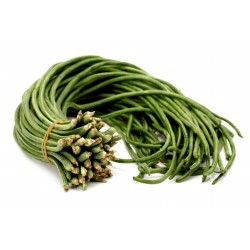
Yard Long Bean, Snake Bean,...
Price
€2.25
SKU: VE 79 (1.9g)
Seeds Gallery Com,
5/
5
<meta http-equiv="Content-Type" content="text/html; charset=UTF-8"><h2><strong>Yard Long Bean, Snake Bean, Chinese Long Bean Seeds</strong></h2><h2><span style="color: #ff0000;" data-mce-style="color: #ff0000;" class="n1ed--selected"><strong>Price for Package of 10-15 (1,9g) seeds.</strong></span></h2><p><strong style="font-size: 14px;" data-mce-style="font-size: 14px;">Yard Long Bean also known as Snake Bean, Asparagus Bean or Chinese Long Bean produces long, thin round bean pods with a slightly sweet taste. The pods can grow up to 100cm long but are at their best picked when about 30cm long and the thickness of a pencil, then they will be tender and sweet rather than tough.</strong></p><p>Yard Long Beans are best grown under the protection of a polytunnel/greenhouse in the UK although they can be grown outside in a long hot summer. It is a climbing bean that can reach 2m tall so will need a frame or wigwam of poles to climb up and tied to as with Runner beans or French Beans.</p><p>Yard Long Bean produces pretty delicate purple flowers and the pods hang down in pairs. To keep them producing beans, regularly pick and use the bean fresh within 1-2 days. They are a very productive plant given the protection of a greenhouse and lots of heat although can be held back if a little cold.</p><p>Yard Long Beans are a staple of South East Asian/Thailand cuisine but are also used in Hindi (Chori) and Caribbean (bora) cooking. They can be steamed or stir-fried and are great in curries. Cut the pods into 10cm lengths and treat like French Beans. If any of the pods are allowed to mature, the beans in the pods can be shelled, dried and kept in an airtight container for use in soups and stews etc. The beans will require soaking overnight in water and boiling vigorously for 10 minutes before simmering until tender so as to destroy any toxins as with most pulses.</p><p>Yard Long Bean is an unusual bean that is well worth growing, but to get the best pick young and tender and use fresh but perhaps allow a couple to grow on have a competition to try growing the longest pod. It’s a bean feast!</p><p><br></p><div><span style="font-size: 10pt; color: #0000ff;" data-mce-style="font-size: 10pt; color: #0000ff;"><strong><span contenteditable="false" data-mce-object="iframe" class="mce-preview-object mce-object-iframe" data-mce-p-class="embed-responsive-item" data-mce-p-frameborder="0" data-mce-p-src="https://www.youtube.com/embed/CyDsxnUGO90?rel=0&hd=1" data-mce-html="%A0"><div class="n1ed_cover" data-cke-hidden-sel="true" contenteditable="false" style="z-index:200;left:0px;top:0px;width:640px;height:385px"></div><iframe src="https://www.youtube.com/embed/CyDsxnUGO90?rel=0&hd=1" class="embed-responsive-item" width="640" height="385" frameborder="0"></iframe><span class="mce-shim"></span></span></strong></span></div>
VE 79 (1.9g)


Variety from Peru
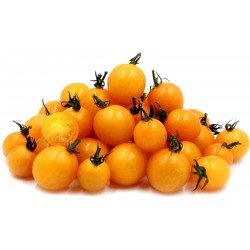
Yellow Cherry Tomato Seeds
Price
€1.85
SKU: VT 82
Seeds Gallery Com,
5/
5
<h2 class=""><strong>Yellow Cherry Tomato Seeds</strong></h2>
<h2><span style="color: #ff0000;"><strong>Price for Package of 20 seeds.</strong><strong><br></strong></span></h2>
<div>A beautiful ornamental edible, which forms compact, bushy, determinate, 12-inch tall plants. Balconi Yellow averages over 100 fruits per plant, carried in large, showy trusses. Their flavor delivers an excellent balance of sweetness and acidity. We frequently see Balconi Red and Yellow promoted as trailing plants, which they are not. Growth is upright. However, the weight of the fruit clusters will often provide the plants with a more spreading appearance. Balconi Yellow has excelled in taste tests and is a superb plant for providing a wealth of delicious fruits, whether planted in the garden or in moderate-sized containers.</div><script src="//cdn.public.n1ed.com/G3OMDFLT/widgets.js"></script>
VT 82 (20 S)


